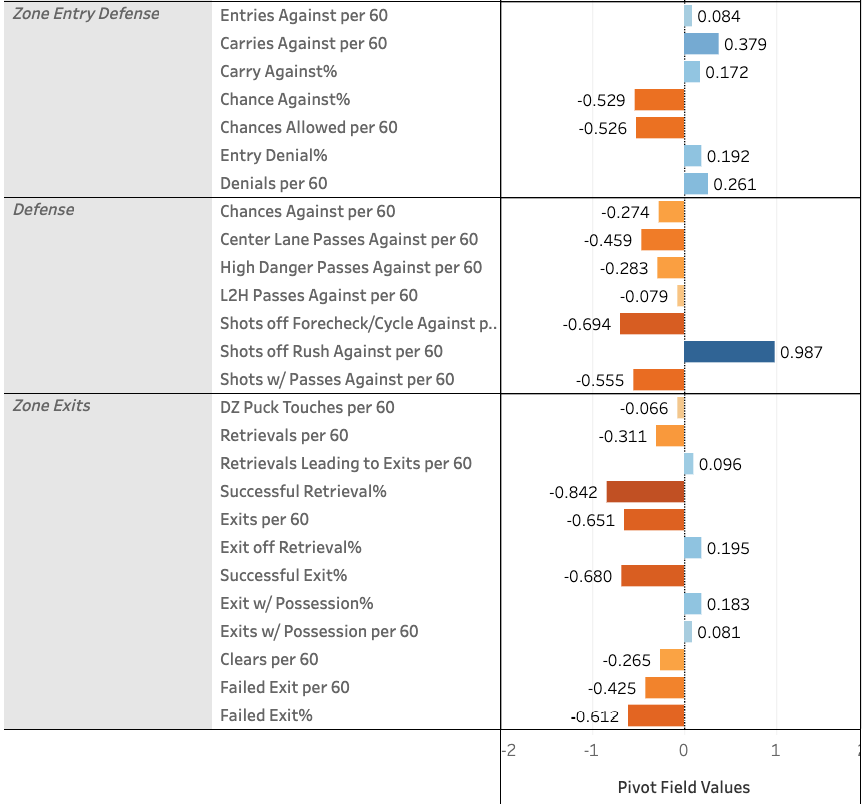Tactical Shifts: How do the Sens Fare?
We dive into the Sens' tactics -- and what has changed during DJ Smith's tenure as coach.

Whether it was because of the length of time it's going to take for him to be fully in charge or if it was the decision he was always going to make, Michael Andlauer has kept Pierre Dorion as the team's general manager and D.J. Smith as head coach.
Silver Seven feels like one of the few places in the Sens sphere that have graded Dorion and Smith similarly on average, with our end-of-season grades giving the duo both a B- compared to readers of The Athletic, for example, who dished out a B for Dorion and a C for Smith. While it seems like Dorion's decisions post-Melnyk have increased people's perception of his ability, Smith has not received the same warmth from the fanbase as he's gotten from his players.
I want to note that I think it's easier to blame a coaching staff and their tactics compared to questioning the players responsible for executing those strategies and the talent identifiers who constructed the roster in the first place. It's easier to fire a coach than to make wholesale changes with the on-ice personnel.
In this article, we'll look to complicate these matters by focusing on what's observable rather than what's easy. For example, while most coaches don't have much control over the players they have available to them, they do control how they're utilized – both in terms of ice-time and how they're asked to play. We'll look to keep these messy layers in mind as we work towards how Smith and co. could look to improve for 2023-24.
Unlike soccer or basketball, most hockey coaches at an elite level use similar tactics, with a 1-2-2 offensive zone forecheck, a 1-3-1 powerplay, a 1-1-3 neutral zone all widespread among NHL clubs. That's not to say that there aren't differences unique to teams – Guy Boucher's neutral zone and Rod Brind'amour's forecheck are examples of tactical innovations that have been associated with the head coach who popularized them – but a read of Ryan Stimson's Tape to Space or Jack Han's Hockey Tactics' series highlight the similar structures that most coaches utilize and the areas ripe for innovation. By my eye, there appears to be more variation in results league-wide due to the execution of the players or the fit with player personnel rather than how players in certain positions are asked to play.
Here's what I noted in the Hockey Tactics 2023 ebook:
— Jack Han (@JhanHky) May 15, 2023
OTT's structure was fine, but they sometimes had trouble transitioning between phases of play. Their younger players will get better at this in time. Their vets likely won't be around then. pic.twitter.com/pw65OkhFlk
In an interview with The Athletic's Ian Mendes at the 2023 NHL Draft, Smith outlined a few of the key changes he wanted to see. Over the next two articles, I'll attempt to take stock of how the team has performed over their last three seasons, outline areas of improvement and opportunity, and try to illuminate a path forward for this team achieve Smith's stated team identity:
“We want to be up-tempo, we want to score and we want to be physical”
2020-21 to 2021-22 to 2022-23: Has anything changed?
As a team, the Senators finished in the middle of the pack – 16th – in 5-on-5 expected goals percentage this season according to data from Evolving-Hockey, with 51.25%. Among playoff teams, that's closest to the Tampa Bay Lightning (51.30%) and Seattle Kraken (51.71%), and ahead of three playoff teams. You might be surprised to learn that while the data indicates that the team's strength is in what it generates offensively (9th in xGF/60), the Senators still rank 16th in xGA/60 – slightly ahead of the Lightning, New York Islanders, and Florida Panthers.
| Year | xG% | xGF/60 | xGA/60 |
|---|---|---|---|
| 2022-23 | 51.25 (16) | 2.83 (9) | 2.69 (16) |
| 2021-22 | 46.69 (25) | 2.37 (22) | 2.71 (26) |
| 2020-21 | 47.73 (22) | 2.25 (13) | 2.47 (24) |
The results are a marked return-to-form to the offensive flairs we saw from the COVID-shortened season, and an upgrade in terms of defensive performance. Note that the team basically gave up chances at the same rate as 2021-22, but since the league as a whole was worse off defensively (or better off offensively...), the Senators saw their relative ranking climb. Qualitatively, how did this happen? Thanks to the painstaking tracking data compiled by Corey Sznajder, we can add more nuance to where these improvements were and where the team still struggles.
Offensively, you can observe that the Sens have grown into a pretty balanced team – generating chances off the rush and creating through the cycle. When inside the offensive zone, Sznajder's data indicates that the team generally favoured point shots over more high danger opportunities like passing from the centre lane, behind-the-net, or looking for cross seam plays in 2020-21 and 2021-22, but that started to shift in 2022-23 in favour of a more diverse set-up.
One of my (and many other Senators fans') biggest frustrations have been with the "dump and chase" tactic that it seemed like the team used regularly as opposed to getting the puck into the offensive zone with control. While our gripe definitely has some legs to stand on – the team ranked in the bottom quartile of the league in that metric – it was surprising to see the gradual shifts in how important controlled entries are as a marker of playoff qualification. My interpretation of the data suggests that it's less about a certain play style being the right way to play and more about what you do to generate offence as you transition the puck through the neutral zone.
| Year | Carry-in % | League rank | # of teams to make playoffs |
|---|---|---|---|
| 2022-23 | 46.7 | 25th | 8 >49.1% average |
| 2021-22 | 45.3 | 32nd | 10 >51.3% average |
| 2020-21 | 43.2 | 25th | 11 >46% average |
What about defensively?

Sznajder's data helps us pinpoint Ottawa's defensive woes, and the patterns are pretty consistent year-over-year in the data he has tracked. In short, the team generally does a good job of stifling shots off of the rush and preventing opponents from carrying the puck into their defensive zone. Of the team's returning defenders, all but Thomas Chabot prevented carry-ins against and denied entries at a better rate than the league average of 58.3% and 9% respectively, with Jakob Chychrun, Erik Brännström, and Artem Zub grading out as the team's most aggressive blueline defenders. However, once an opponent makes it into the Senators end, they're usually able to feast, with only Brännström and Zub ranking above the league-average in preventing scoring chances off of zone entries. As a team, the data suggests that the Senators are able to do a better job preventing teams from reloading the points (low-to-high passes against per 60) than they're able to cut off passing plays or shots off of the cycle.
In terms of exiting the zone, the Senators struggle to successfully retrieve the puck on a regular basis, with Jake Sanderson and Chabot taking on a lot of that burden. While Chychrun doesn't retrieve at a high rate, he does help out as a puck transporter once he's given the puck in the defensive zone – helping the team avoid needless clears. Ultimately, though, there are a lot of botched exits at the blueline, meaning that there's a lot for Smith and co. to look into here in terms of what lanes are available to defenders to get the puck out. As Jack Han noted about the team's breakout tactics earlier, it looks like if the forward playing centre wasn't available to receive the puck in the middle of the ice, the wingers were too far away for a successful pass attempt; hence, pucks were either picked off or the defender succumbed to the pressure of the incoming forechecker.
Bringing back a quote from Mendes' article, Smith remarked:
“The biggest thing is details. It has to be tightened up. The accountability towards small details becomes tighter and tighter as you want to get better. As the players get better, the mistakes have to be less and less. They know better. And the accountability has to be higher,” Smith says. “And it’s not just me, they are going hold themselves to a higher standard. They know where they want to go. Just letting guys play throughout it is not something you have with a team that expects to win. If you’re not going, someone else has to take your spot.”
Looking at the data, it appears as though the Senators have some details worked out – they're flexible offensively, able to be aggressive when defending the rush, and can cut off lanes to the point – while struggling with in-zone defence and on breakouts.
Next week, we'll continue this series by looking at the team's personnel in 2023-24 and see if there are certain combinations of players – at forward and on the back-end – that can remedy some of these issues.


